SKODA OCTAVIA TOUR 2009 1.G / (1U) Owners Manual
Manufacturer: SKODA, Model Year: 2009, Model line: OCTAVIA TOUR, Model: SKODA OCTAVIA TOUR 2009 1.G / (1U)Pages: 224, PDF Size: 13.53 MB
Page 91 of 224
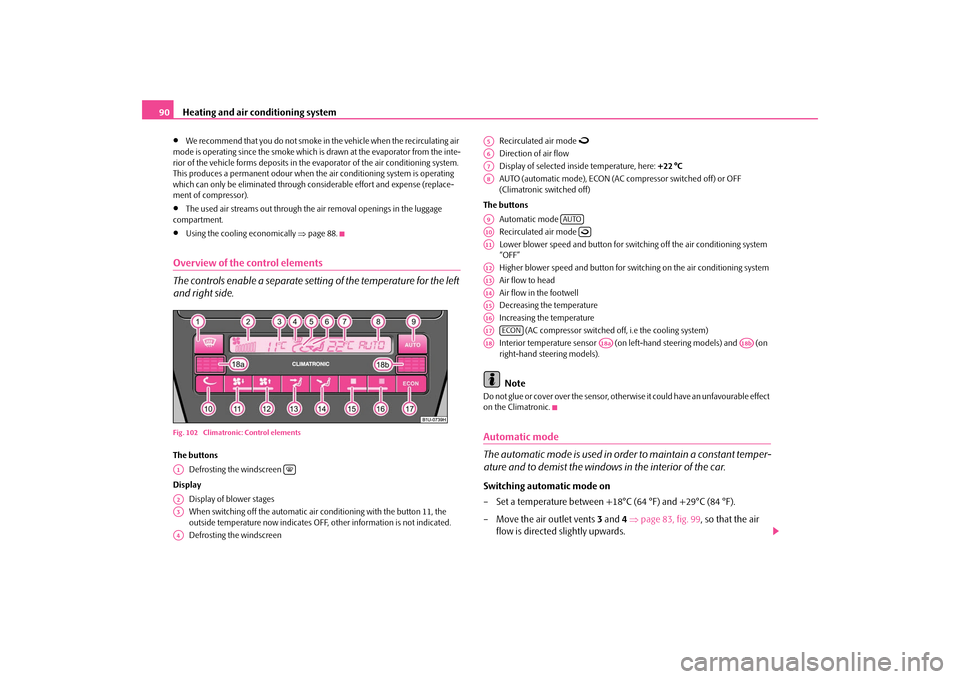
Heating and air conditioning system
90
•
We recommend that you do not smoke in the vehicle when the recirculating air
mode is operating since the smoke which is drawn at the evaporator from the inte- rior of the vehicle forms deposits in the
evaporator of the air
conditioning system.
This produces a permanent odour when the air conditioning system is operating which can only be eliminated through considerable effort and expense (replace- ment of compressor).•
The used air streams out through the air removal openings in the luggage
compartment.•
Using the cooling economically
⇒page 88.
Overview of the control elements The controls enable a separate setti
ng of the temperature for the left
and right side.Fig. 102 Climatronic: Control elementsThe buttons
Defrosting the windscreen
Display
Display of blower stages When switching off the automatic air co
nditioning with the button 11, the
outside temperature now indicates OFF, other information is not indicated. Defrosting the windscreen
Recirculated air mode
Direction of air flow Display of selected inside temperature, here:
+22 °C
AUTO (automatic mode), ECON (AC
compressor switched off) or OFF
(Climatronic switched off)
The buttons
Automatic mode Recirculated air mode Lower blower speed and button for switch
ing off the air conditioning system
“OFF” Higher blower speed and button for switching on the air conditioning system Air flow to head Air flow in the footwellDecreasing the temperature Increasing the temperature
(AC compressor switched off, i.e the cooling system)
Interior temperature sensor (on le
ft-hand steering models) and (on
right-hand stee
ring models).
Note
Do not glue or cover over the sensor, otherw
ise it could have an unfavourable effect
on the Climatronic.Automatic mode The automatic mode is used in order to maintain a constant temper- ature and to demist the windows in the interior of the car.Switching automatic mode on – Set a temperature between +18°C (64 °F) and +29°C (84 °F). – Move the air outlet vents
3 and
4 ⇒
page 83, fig. 99
, so that the air
flow is directed slightly upwards.
A1
A2A3A4
A5A6A7A8A9
AUTO
A10
A11A12A13A14A15A16A17
ECON
A18
A18a
A18b
s2g8.b.book Page 90 Tuesday, April 7, 2009 8:53 AM
Page 92 of 224
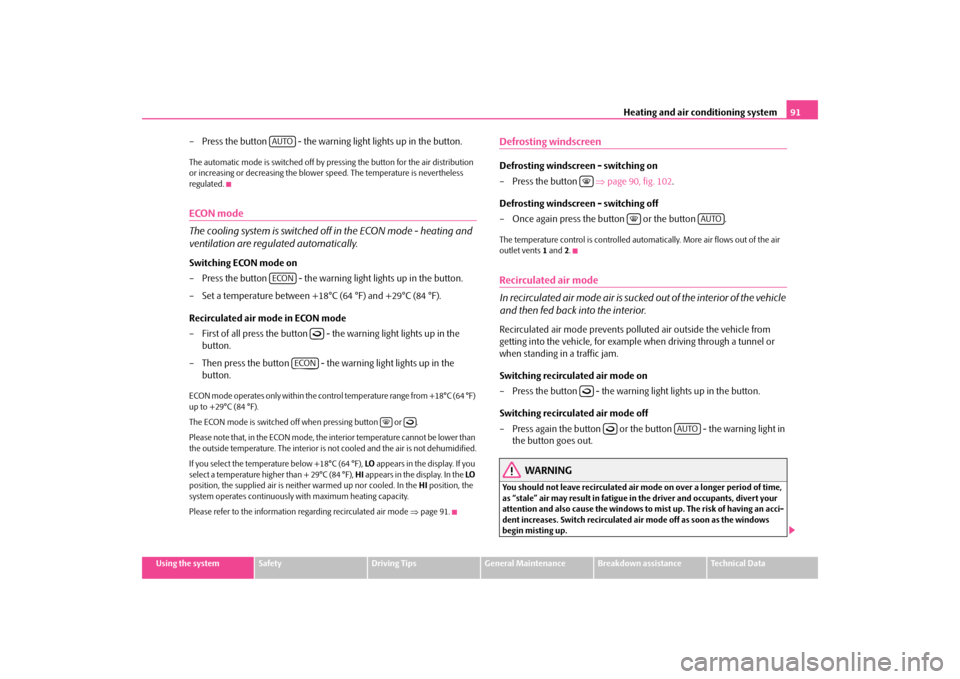
Heating and air conditioning system
91
Using the system
Safety
Driving Tips
General Maintenance
Breakdown assistance
Technical Data
– Press the button - the warning light lights up in the button.The automatic mode is switched off by pr
essing the button for the air distribution
or increasing or decreasing the blower speed. The temperature is nevertheless regulated.ECON mode The cooling system is switched off in the ECON mode - heating and ventilation are regulated automatically.Switching ECON mode on – Press the button - the warning light lights up in the button. – Set a temperature between +18°C (64 °F) and +29°C (84 °F). Recirculated air mode in ECON mode – First of all press the button - the warning light lights up in the
button.
– Then press the button - the warning light lights up in the
button.
ECON mode operates only within the control temperature range from +18°C (64 °F) up to +29°C (84 °F). The ECON mode is switched off when pressing button or .Please note that, in the ECON mode, the interior temperature cannot be lower than the outside temperature. The interior is not cooled and the air is not dehumidified. If you select the temperature below +18°C (64 °F),
LO appears in the display. If you
select a temperature higher than + 29°C (84 °F),
HI appears in the display. In the
LO
position, the supplied air is neit
her warmed up nor cooled. In the
HI position, the
system operates cont
inuously with maximum heating capacity.
Please refer to the information regarding recirculated air mode
⇒page 91.
Defrosting windscreenDefrosting windscreen - switching on –Press the button
⇒
page 90, fig. 102
.
Defrosting windscreen - switching off – Once again press the button or the button .The temperature control is controlled auto
matically. More air flows out of the air
outlet vents
1 and
2.
Recirculated air mode In recirculated air mode air is sucked
out of the interior of the vehicle
and then fed back into the interior.Recirculated air mode prevents polluted air outside the vehicle from getting into the vehicle, for example when driving through a tunnel or when standing in a traffic jam. Switching recirculated air mode on – Press the button - the warning light lights up in the button. Switching recirculated air mode off – Press again the button or the button - the warning light in
the button goes out.
WARNING
You should not leave recirculated air mode on over a longer period of time, as “stale” air may result in fatigue in the driver and occupants, divert your attention and also cause the windows to mist up. The risk of having an acci- dent increases. Switch recirculated air mode off as soon as the windows begin misting up.
AUTOECON
ECON
AUTO
AUTO
s2g8.b.book Page 91 Tuesday, April 7, 2009 8:53 AM
Page 93 of 224
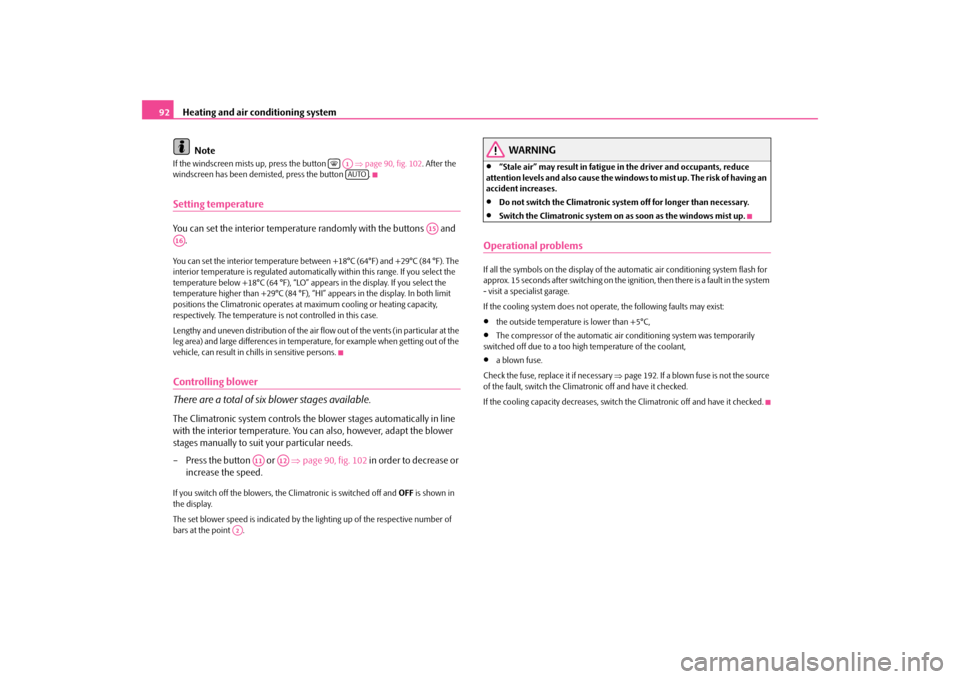
Heating and air conditioning system
92
Note
If the windscreen mists up, press the button
⇒page 90, fig. 102
. After the
windscreen has been demisted, press the button .Setting temperatureYou can set the interior temperature randomly with the buttons and
.
You can set the interior temperature between +18°C (64°F) and +29°C (84 °F). The interior temperature is regulated automatica
lly within this range. If you select the
temperature below +18°C (64 °F), “LO” appe
ars in the display. If you select the
temperature higher than +29°C (84 °F), “H
I” appears in the display. In both limit
positions the Climatronic operates at
maximum cooling or heating capacity,
respectively. The temperature is not controlled in this case. Lengthy and uneven distribution of the air flow out of the vents (in particular at the leg area) and large differences in temperature, for example when getting out of the vehicle, can result in chills in sensitive persons.Controlling blower There are a total of six blower stages available.The Climatronic system controls the bl
ower stages automatically in line
with the interior temperature. You
can also, however, adapt the blower
stages manually to suit
your particular needs.
– Press the button or
⇒
page 90, fig. 102
in order to decrease or
increase the speed.
If you switch off the blowers, th
e Climatronic is switched off and
OFF
is shown in
the display. The set blower speed is indicated by the lighting up of the respective number of bars at the point .
WARNING
•
“Stale air” may result in fatigue in
the driver and occupants, reduce
attention levels and also cause the windows to mist up. The risk of having an accident increases.•
Do not switch the Climatronic syst
em off for longer than necessary.
•
Switch the Climatronic system on as soon as the windows mist up.
Operational problemsIf all the symbols on the display of the au
tomatic air conditioning system flash for
approx. 15 seconds after switching on the ignition, then there is a fault in the system - visit a specialist garage. If the cooling system does not oper
ate, the following faults may exist:
•
the outside temperature is lower than +5°C,
•
The compressor of the automatic air
conditioning system was temporarily
switched off due to a too high temperature of the coolant,•
a blown fuse.
Check the fuse, replace it if necessary
⇒page 192. If a blown fuse is not the source
of the fault, switch the Climatronic off and have it checked. If the cooling capacity decreases, switch
the Climatronic off and have it checked.
A1AUTO
A15
A16
A11
A12
A2
s2g8.b.book Page 92 Tuesday, April 7, 2009 8:53 AM
Page 94 of 224
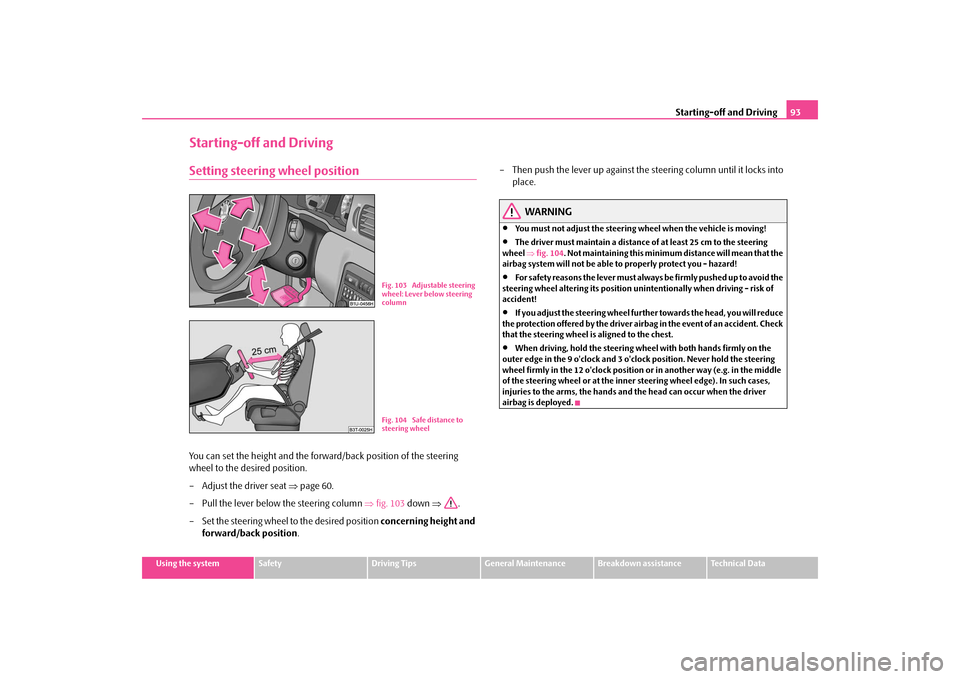
Starting-off and Driving
93
Using the system
Safety
Driving Tips
General Maintenance
Breakdown assistance
Technical Data
Starting-off and DrivingSetting steering wheel positionYou can set the height and the forw
ard/back position of the steering
wheel to the desired position. – Adjust the driver seat
⇒
page 60.
– Pull the lever below the steering column
⇒
fig. 103
down
⇒
.
– Set the steering wheel to the desired position
concerning height and
forward/back position
.
– Then push the lever up against the steering column until it locks into
place.
WARNING
•
You must not adjust the steering wh
eel when the vehicle is moving!
•
The driver must maintain a distance of at least 25 cm to the steering
wheel
⇒fig. 104
. Not maintaining this minimum distance will mean that the
airbag system will not be able to properly protect you - hazard!•
For s a fe t y re a s ons the le v e r m ust a lwa y s b e fi rm l y pus he d up t o a vo id the
steering wheel altering its position unintentionally when driving - risk of accident!•
If you adjust the steering wheel furthe
r towards the head, you will reduce
the protection offered by the driver airb
ag in the event of an accident. Check
that the steering wheel is aligned to the chest.•
When driving, hold the steering wheel
with both hands firmly on the
outer edge in the 9 o'clock and 3 o'clock position. Never hold the steering wheel firmly in the 12 o'clock position or in another way (e.g. in the middle of the steering wheel or
at the inner steering wheel edge). In such cases,
injuries to the arms, the hands and
the head can occur when the driver
airbag is deployed.
Fig. 103 Adjustable steering wheel: Lever below steering columnFig. 104 Safe distance to steering wheel
s2g8.b.book Page 93 Tuesday, April 7, 2009 8:53 AM
Page 95 of 224
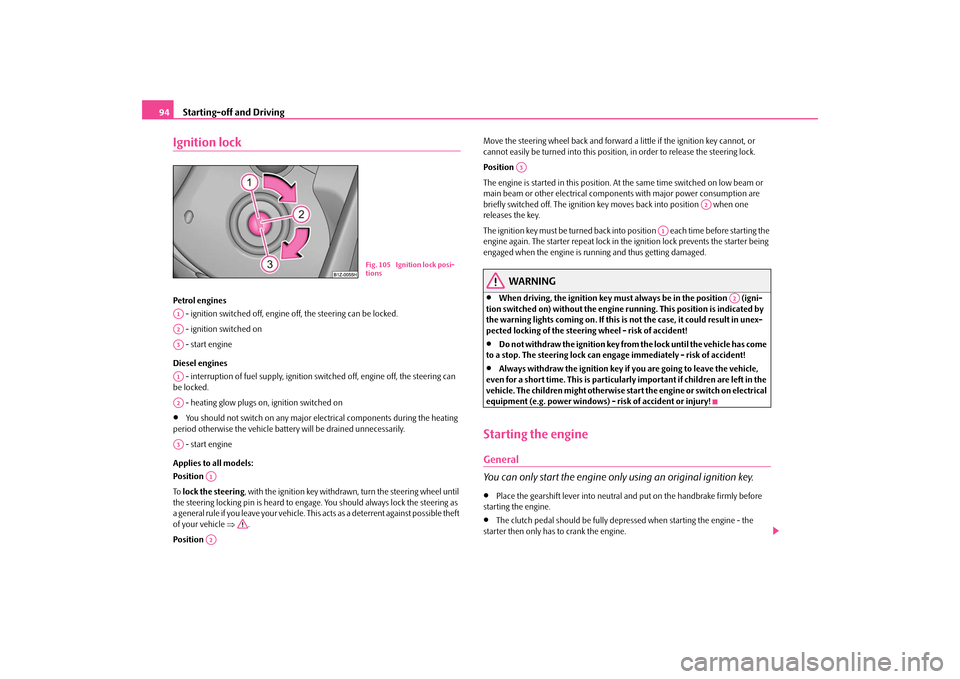
Starting-off and Driving
94
Ignition lockPetrol engines - ignition switched off, engine
off, the steering can be locked.
- ignition switched on - start engine Diesel engines - interruption of fuel supply, ignition sw
itched off, engine off, the steering can
be locked. - heating glow plugs on, ignition switched on•
You should not switch on any major elec
trical components during the heating
period otherwise the vehicle batt
ery will be drained unnecessarily.
- start engine Applies to all models: Position
To lock the steering
, with the ignition key withdrawn, turn the steering wheel until
the steering locking pin is heard to engage. You should always lock the steering as a general rule if you leave your
vehicle. This acts as a deterrent against possible theft
of your vehicle
⇒
.
Position
Move the steering wheel back and forward a little if the ignition key cannot, or cannot easily be turned into
this position, in order to
release the steering lock.
Position
The engine is started in this position. At
the same time switched on low beam or
main beam or other electrical compon
ents with major power consumption are
briefly switched off. The ignition key
moves back into position when one
releases the key. The ignition key must be turned back into position each time before starting the engine again. The starter repeat lock in th
e ignition lock prevents the starter being
engaged when the engine is r
unning and thus getting damaged.
WARNING
•
When driving, the ignition key must always be in the position (igni-
tion switched on) without the engine running. This position is indicated by the warning lights coming on. If this is not the case, it could result in unex- pected locking of the steerin
g wheel - risk of accident!
•
Do not withdraw the ignition key from the lock until the vehicle has come
to a stop. The steering lock can en
gage immediately - risk of accident!
•
Always withdraw the ignition key if
you are going to leave the vehicle,
even for a short time. This is particularly important if children are left in the vehicle. The children might
otherwise start the engine
or switch on electrical
equipment (e.g. power windows) - risk of accident or injury!Starting the engineGeneral You can only start the engine only using an original ignition key.•
Place the gearshift lever into neutral an
d put on the handbrake firmly before
starting the engine.•
The clutch pedal should be fully depr
essed when starting the engine - the
starter then only has to crank the engine.
Fig. 105 Ignition lock posi- tions
A1A2A3A1A2A3
A1A2
A3
A2
A1
A2
s2g8.b.book Page 94 Tuesday, April 7, 2009 8:53 AM
Page 96 of 224
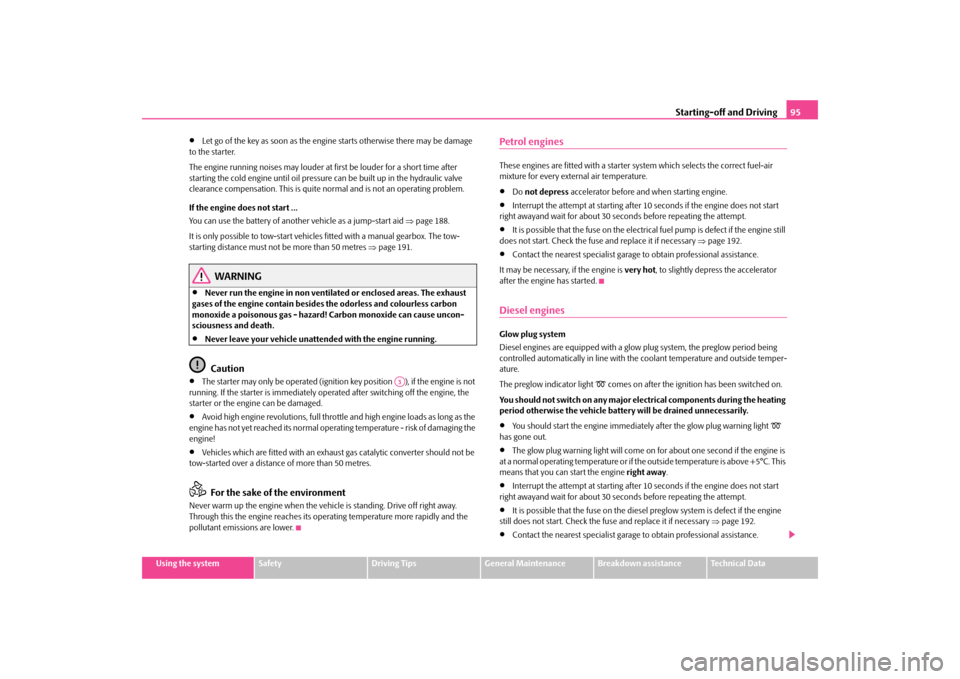
Starting-off and Driving
95
Using the system
Safety
Driving Tips
General Maintenance
Breakdown assistance
Technical Data
•
Let go of the key as soon as the engine starts otherwise there may be damage
to the starter. The engine running noises may louder at
first be louder for
a short time after
starting the cold engine until oil pressure
can be built up in the hydraulic valve
clearance compensation. This is quite normal and is not an operating problem. If the engine does not start ... You can use the battery of anothe
r vehicle as a jump-start aid
⇒page 188.
It is only possible to tow-start vehicl
es fitted with a manual gearbox. The tow-
starting distance must not be more than 50 metres
⇒page 191.
WARNING
•
Never run the engine in non ventilat
ed or enclosed areas. The exhaust
gases of the engine contain besides
the odorless and colourless carbon
monoxide a poisonous gas - hazard! Carbon monoxide can cause uncon- sciousness and death.•
Never leave your vehicle unattended with the engine running.Caution
•
The starter may only be operated (ignition key position ), if the engine is not
running. If the starter is immediately oper
ated after switching off the engine, the
starter or the engine can be damaged.•
Avoid high engine revolutions, full throttle and high engine loads as long as the
engine has not yet reached its normal oper
ating temperature - risk of damaging the
engine!•
Vehicles which are fitted wi
th an exhaust gas catalyti
c converter should not be
tow-started over a distance of more than 50 metres.
For the sake of the environment
Never warm up the engine when the vehi
cle is standing. Drive off right away.
Through this the engine reaches its operating temperature more rapidly and the pollutant emissions are lower.
Petrol enginesThese engines are fitted with a starter system which selects the correct fuel-air mixture for every external air temperature.•
Do
not depress
accelerator before and when starting engine.
•
Interrupt the attempt at starting after
10 seconds if the engine does not start
right awayand wait for about 30 se
conds before repeating the attempt.
•
It is possible that the fuse on the electric
al fuel pump is defect if the engine still
does not start. Check the fuse and replace it if necessary
⇒page 192.
•
Contact the nearest specialist garage to obtain professional assistance.
It may be necessary, if the engine is
very hot
, to slightly depress the accelerator
after the engine has started.Diesel enginesGlow plug system Diesel engines are equipped with a glow
plug system, the preglow period being
controlled automatically in
line with the coolant temperature and outside temper-
ature. The preglow indicator light
comes on after the ignition has been switched on.
You should not switch on any major electrical components during the heating period otherwise the vehicle battery will be drained unnecessarily.•
You should start the engine immediately after the glow plug warning light
has gone out.•
The glow plug warning light will come on for about one second if the engine is
at a normal operating temperature or if the outside temperature is above +5°C. This means that you can start the engine
right away
.
•
Interrupt the attempt at starting after
10 seconds if the engine does not start
right awayand wait for about 30 se
conds before repeating the attempt.
•
It is possible that the fuse on the diesel preglow system is defect if the engine
still does not start. Check the fuse and replace it if necessary
⇒page 192.
•
Contact the nearest specialist garage to obtain professional assistance.
A3
s2g8.b.book Page 95 Tuesday, April 7, 2009 8:53 AM
Page 97 of 224

Starting-off and Driving
96
Starting the engine after the fuel tank has run dry It may take longer than normal to start the
engine after refuelling
if the fuel tank has
run completely dry - up to one minute. This is because the fuel system must first of all be filled while the attempting to start the engine.Switching off the engine– The engine can be swit
ched off by turning the ignition key from posi-
tion into
⇒
page 94, fig. 105
.
WARNING
•
Never switch off the engine before the
vehicle is stationary - risk of acci-
dent!•
The brake booster only operates when the engine is running. Greater
physical effort for braking is required
when engine is switched off. Because
if you do not stop as normal, this can cause an accident and severe injuries.
Caution
you should not switch the engine off right
away at the end of your journey after the
engine has been operated fo
r a lengthy period at high
loads but should be allowed
it to run at idling speed for about 2 minutes
. This prevents any accumulation of heat
when the engine is switched off.
Note
•
The radiator fan may continue running fo
r a further 10 minutes or so after the
engine and the ignition have been switched
off. The coolant fan may, however, also
switch on again after some time if the coolant temperature rises because of an accumulation of heat in the engine or
if the engine is warm and the engine
compartment is additionally
heated by strong sunlight.
•
This is why particular care is required when carrying out any work in the engine
compartment
⇒page 160, “Working in the engine compartment”.
ShiftingShift into reverse only when the vehicle is
stationary. Depress the clutch pedal and
hold it fully depressed. Wa
it a moment before engaging reverse gear in order to
avoid any shift noises. The reversing lights will come on once reverse gear is engaged, provided the igni- tion is on.
WARNING
Never engage the reverse gear when driving - risk of accident!
Note
•
One should not lay the hand on the shift lever while driving the vehicle. The
pressure of the hand will be transferred to
the gearshift forks in the gearbox. This
can, over a period of time, lead to
early wear of the gearshift forks.
•
Depress the clutch pedal fully when chan
ging gears, in order to avoid unneces-
sary wear and damage.
A1
Fig. 106 Shift pattern on models fitted with 5-speed manual gearbox
s2g8.b.book Page 96 Tuesday, April 7, 2009 8:53 AM
Page 98 of 224
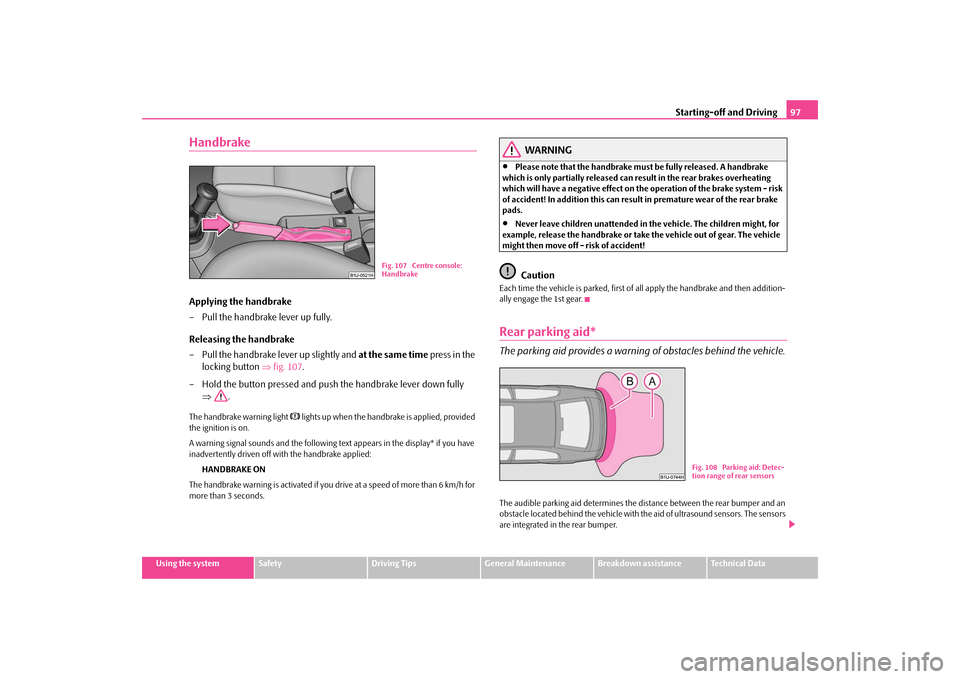
Starting-off and Driving
97
Using the system
Safety
Driving Tips
General Maintenance
Breakdown assistance
Technical Data
HandbrakeApplying the handbrake – Pull the handbrake lever up fully. Releasing the handbrake – Pull the handbrake lever up slightly and
at the same time
press in the
locking button
⇒
fig. 107
.
– Hold the button pressed and push the handbrake lever down fully
⇒
.
The handbrake warning light
lights up when the handbrake is applied, provided
the ignition is on. A warning signal sounds and the following text appears in the display* if you have inadvertently driven off with the handbrake applied:
HANDBRAKE ON
The handbrake warning is activated if you drive at a speed of more than 6 km/h for more than 3 seconds.
WARNING
•
Please note that the handbrake must be fully released. A handbrake
which is only partially released can re
sult in the rear brakes overheating
which will have a negative effect on th
e operation of the brake system - risk
of accident! In addition this can result in premature wear of the rear brake pads.•
Never leave children unattended in the vehicle. The children might, for
example, release the handbrake or take
the vehicle out of gear. The vehicle
might then move off - risk of accident!
Caution
Each time the vehicle is parked, first of
all apply the handbrake and then addition-
ally engage the 1st gear.Rear parking aid*The parking aid provides a warning of obstacles behind the vehicle.The audible parking aid determines the distance between the rear bumper and an obstacle located behind the vehicle with th
e aid of ultrasound sensors. The sensors
are integrated in the rear bumper.
Fig. 107 Centre console: Handbrake
Fig. 108 Parking aid: Detec-tion range of rear sensors
s2g8.b.book Page 97 Tuesday, April 7, 2009 8:53 AM
Page 99 of 224
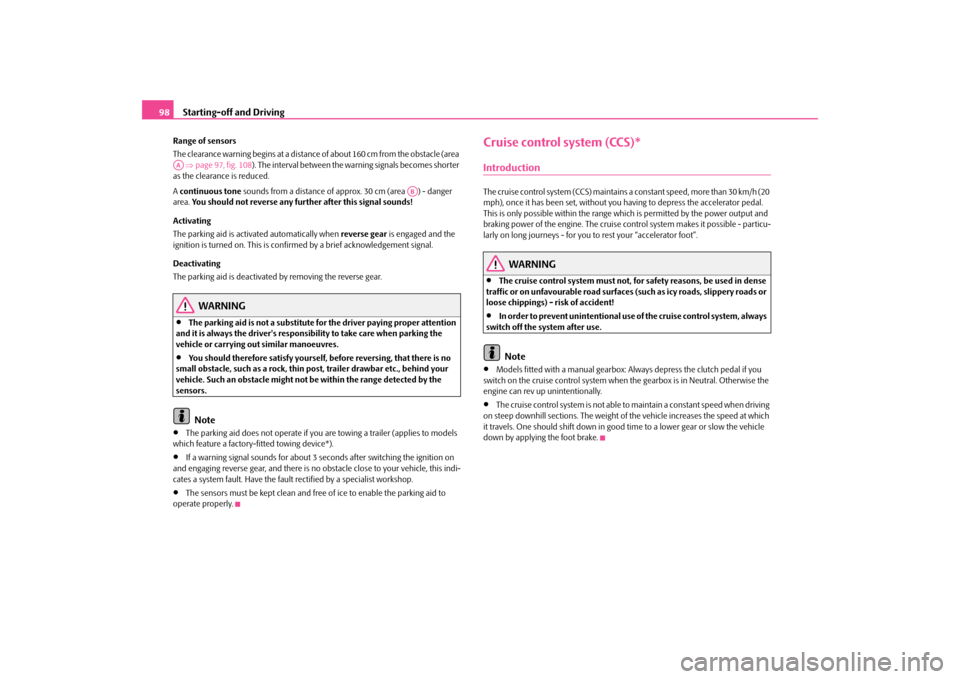
Starting-off and Driving
98
Range of sensors The clearance warning begins at a distance of about 160 cm from the obstacle (area ⇒page 97, fig. 108
). The interval between the warning signals becomes shorter
as the clearance is reduced. A continuous tone
sounds from a distance of approx. 30 cm (area ) - danger
area.
You should not reverse any further after this signal sounds!
Activating The parking aid is activated automatically when
reverse gear
is engaged and the
ignition is turned on. This is confir
med by a brief acknowledgement signal.
Deactivating The parking aid is deactivated by removing the reverse gear.
WARNING
•
The parking aid is not a substitute fo
r the driver paying proper attention
and it is always the driver's responsibility to take care when parking the vehicle or carrying ou
t similar manoeuvres.
•
You should therefore satisfy yourself, before reversing, that there is no
small obstacle, such as a rock, thin post, trailer drawbar etc., behind your vehicle. Such an obstacle might not be within the range detected by the sensors.
Note
•
The parking aid does not operate if you
are towing a trailer (applies to models
which feature a factory-fitted towing device*).•
If a warning signal sounds for about 3 seconds after switching the ignition on
and engaging reverse gear, and there is no ob
stacle close to your vehicle, this indi-
cates a system fault. Have the fault rectified by a specialist workshop.•
The sensors must be kept clean and free
of ice to enable the parking aid to
operate properly.
Cruise control system (CCS)*IntroductionThe cruise control system (CCS) maintains a constant speed, more than 30 km/h (20 mph), once it has been set, without you
having to depress the accelerator pedal.
This is only possible within the range wh
ich is permitted by
the power output and
braking power of the engine. The cruise control system makes it possible - particu- larly on long journeys - for you to rest your “accelerator foot”.
WARNING
•
The cruise control system must not, for safety reasons, be used in dense
traffic or on unfavourable road surfaces
(such as icy roads, slippery roads or
loose chippings) - risk of accident!•
In order to prevent unintentional use of
the cruise control system, always
switch off the system after use.
Note
•
Models fitted with a manual gearbox: Al
ways depress the clutch pedal if you
switch on the cruise control system when
the gearbox is in Neutral. Otherwise the
engine can rev up unintentionally.•
The cruise control system is not able to maintain a constant speed when driving
on steep downhill sections. The weight of the vehicle increases the speed at which it travels. One should shift down in good
time to a lower gear or slow the vehicle
down by applying the foot brake.
AA
AB
s2g8.b.book Page 98 Tuesday, April 7, 2009 8:53 AM
Page 100 of 224
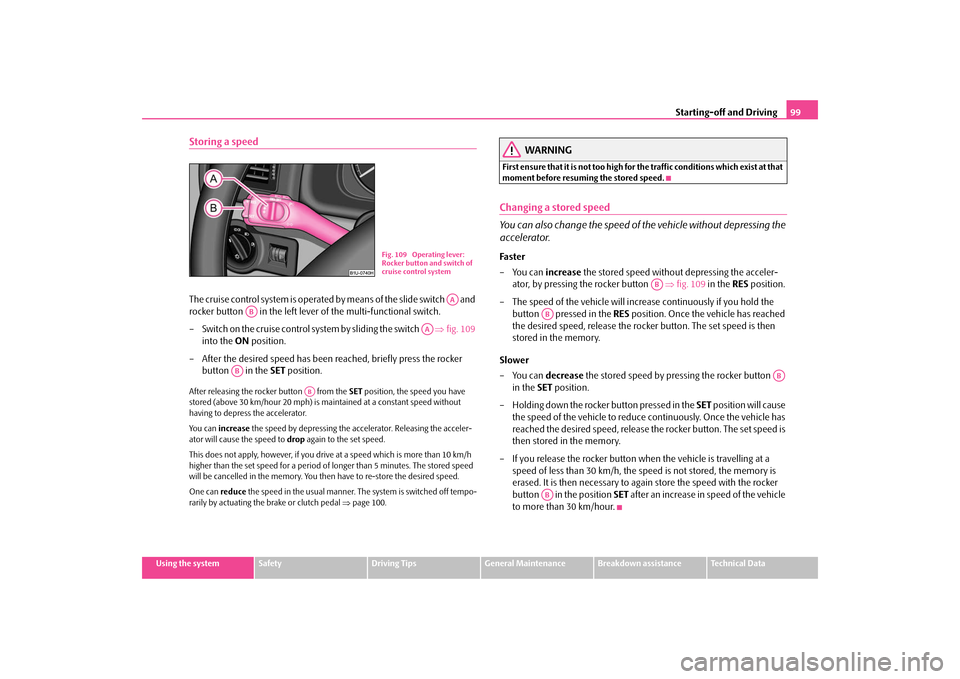
Starting-off and Driving
99
Using the system
Safety
Driving Tips
General Maintenance
Breakdown assistance
Technical Data
Storing a speedThe cruise control system is operated
by means of the slide switch and
rocker button in the left lever of the multi-functional switch. – Switch on the cruise control system by sliding the switch
⇒
fig. 109
into the
ON
position.
– After the desired speed has been
reached, briefly press the rocker
button in the
SET
position.
After releasing the rocker button from the
SET
position, the speed you have
stored (above 30 km/hour 20 mph) is ma
intained at a constant speed without
having to depress the accelerator. Yo u c a n
increase
the speed by depressi
ng the accelerator. Releasing the acceler-
ator will cause the speed to
drop
again to the set speed.
This does not apply, however, if you drive at a speed which is more than 10 km/h higher than the set speed for a period of longer than 5 minutes. The stored speed will be cancelled in the memory. You th
en have to re-store the desired speed.
One can
reduce
the speed in the usual manner. The system is switched off tempo-
rarily by actuating the brake or clutch pedal
⇒page 100.
WARNING
First ensure that it is not too high for the traffic conditions which exist at that moment before resuming the stored speed.Changing a stored speed You can also change the speed of
the vehicle without depressing the
accelerator.Fa s t er –You can
increase
the stored speed without depressing the acceler-
ator, by pressing the rocker button
⇒
fig. 109
in the
RES
position.
– The speed of the vehicle will incr
ease continuously if you hold the
button pressed in the
RES
position. Once the vehicle has reached
the desired speed, release the rocker button. The set speed is then stored in the memory.
Slower –You can
decrease
the stored speed by pressing the rocker button
in the
SET
position.
– Holding down the rocker button pressed in the
SET
position will cause
the speed of the vehicle to reduce
continuously. Once the vehicle has
reached the desired speed, release the rocker button. The set speed is then stored in the memory.
– If you release the rocker button wh
en the vehicle is travelling at a
speed of less than 30 km/h, the speed is not stored, the memory is erased. It is then necessary to again store the speed with the rocker button in the position
SET
after an increase in speed of the vehicle
to more than 30 km/hour.
Fig. 109 Operating lever: Rocker button and switch of cruise control system
AA
AB
AA
AB
AB
AB
AB
AB
AB
s2g8.b.book Page 99 Tuesday, April 7, 2009 8:53 AM